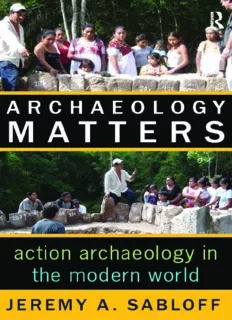
Archaeology Matters: Action Archaeology in the Modern World PDF
Preview Archaeology Matters: Action Archaeology in the Modern World
Archaeology Matters Key Questions in Anthropology: Little Books on Big Ideas Series Editor: H. Russell Bernard Key Questions in Anthropology publishes small books on large topics. Each of the distinguished authors summarizes one of the key debates in the field briefly, comprehensively, and in a style accessible to college undergraduates. Anthropology’s enduring questions and perennial debates are addressed here in a fashion that is both authoritative and conducive to fostering class debate, research, and writing. Proposals for books in the series should be addressed to [email protected] Series Editor H. Russell Bernard (emeritus, University of Florida), has been editor of the journals American Anthropologist, Human Orga- nization, and Field Methods, and of the series Frontiers of Anthropol- ogy. He is author of the leading textbook on field methods and has published extensively in cultural, applied, and linguistic anthropology. He is recipient of the prestigious AAA Franz Boas Award. Series Titles Archaeology Matters: Action Archaeology in the Modern World Jeremy A. Sabloff The Origin of Cultures: How Individual Choices Make Cultures Change W. Penn Handwerker AIDS, Behavior, and Culture: Understanding Evidence- Based Prevention Edward C. Green and Allison Herling Ruark Archaeology Matters Action Archaeology in the Modern World Jeremy A. Sabloff University of Pennsylvania First published 2008 by Left Coast Press, Inc. Published 2016 by Routledge 2 Park Square, Milton Park, Abingdon, Oxon OX14 4RN 711 Third Avenue, New York, NY 10017, USA Routledge is an imprint of the Taylor & Francis Group, an informa business Copyright © 2008 Taylor & Francis All rights reserved. No part of this book may be reprinted or reproduced or utilised in any form or by any electronic, mechanical, or other means, now known or hereafter invented, including photocopying and recording, or in any information storage or retrieval system, without permission in writing from the publishers. Notice: Product or corporate names may be trademarks or registered trademarks, and are used only for identification and explanation without intent to infringe. Library of Congress Cataloguing-in-Publication Data Sabloff, Jeremy A. Archaeology matters : action archaeology in the modern world / Jeremy A. Sabloff. p. cm. Includes bibliographical references and index. isbn 978-1-59874-089-9 (pbk. : alk. paper) isbn 978-1-59874-088-2 (hardback : alk. paper) 1. Archaeology. 2. Antiquities. 3. Archaeology--Methodology. 4. Archaeology—Social aspects. I. Title. CC165.S23 2008 930.1—dc22 2008000916 ISBN 978-1-59874-088-2 hardcover ISBN 978-1-59874-089-9 paperback Text design by Detta Penna Index by Erica Hill For Paula Again, and always This page intentionally left blank Contents List of Illustrations 8 Preface 11 Acknowledgments 12 chapter one The Importance of the Past for the Present 15 chapter Lessons from the Past? 33 two How Can the Prospects for chapter three a Sustainable World Be Improved? 47 chapter four Is Warfare Inevitable? 59 chapter five Why Cities? 69 What Can Be Done to Preserve chapter six the World’s Historical Heritage? 79 chapter Future Directions 93 seven chapter Epilogue 103 eight Following Up the Book’s Themes: appendix An Introductory Guide 111 Notes 119 References 127 Index 145 About the Author 151 List of Illustrations Cover. Oliberto Us May and George J. Bey, III guiding the local residents of Yaxhachen on a tour of the ancient Maya archaeological site of Kiuic in Yucatan, Mexico. Figure 1. Construction of experimental raised fields in the Community of Bermeo, Bolivia (1992). Figure 2. Members of the Community of Bermeo and their experimental raised fields (1992). The community later harvested a bumper crop of manioc and peanuts. Sadly, these fields are now abandoned. Figure 3. Cochiti Mesa, New Mexico, where historic Kotyiti Pueblo is located. Figure 4. Students and archaeologists of the Archaeology of the Colorado Coal Field War Project in front of the United Mine Workers of America Ludlow Massacre monument (2001). Figure 5. Map of the Maya Lowlands. Figure 6. Excavations in front of Temple 1 at the great Maya site of Tikal, Guatemala. Figure 7. The remains of a perishable wood and thatch peasant’s house with a single row stone foundation (and doorway at the center), ca. A.D. 800, at the site of Sayil, Mexico. Figure 8. Tropical forest environment in the Southern Maya Lowlands. Figure 9. Cuneiform tablet from about 1500 B.C. showing a plan of an estate with its agricultural fields (waterways are drawn as they pass through fields, while circles indicate villages [width: 11cm]). Figure 10. Excavation at site CA-SMI-232 on San Miguel Island revealed a concentrated “bone bed” (see inset) with fish, shellfish, and sea mammal remains. Figure 11. Defensive wall of the fortress of Sacsayhuaman, Peru. A horse stands in front of three tiers of massive stone fortifications with typical, intricately cut and fitted Inca stonework. Figure 12. The Valley of Oaxaca near the great Zapotec capital of Monte Alban. Figure 13. A sculpture of a conquered figure at Monte Alban. Figure 14. The ancient city of Ur, Iraq from the air (1930). Figure 15. A looted cemetery at the El Brujo Archaeological Complex in the Chicama Valley, Peru. Figure 16. One of the most famous examples of archaeological preservation in recent times: the saving of the giant sculptures at Abu Simbel, Egypt from the waters of Lake Nasser. Figure 17. Aleut elders visiting with Herbert Maschner to discuss the archaeological project at King Cove, Alaska. In the Middle Ages, wise men used to say ‘History is the school of princes’. Today it ought to be the school of democracy. Americans, fortunate in their power and prosperity, have many unavoidable responsibilities in the world, and in discharging them should study the past, even the remote past, to find any guidance it has to offer. PAUL JOHNSON Archaeology is perhaps the best tool we have for looking ahead, because it provides a deep reading of the direction and momentum of our course through time: what we are, what we have come from, and therefore where we are most likely to be going. RONALD WRIGHT
Description: